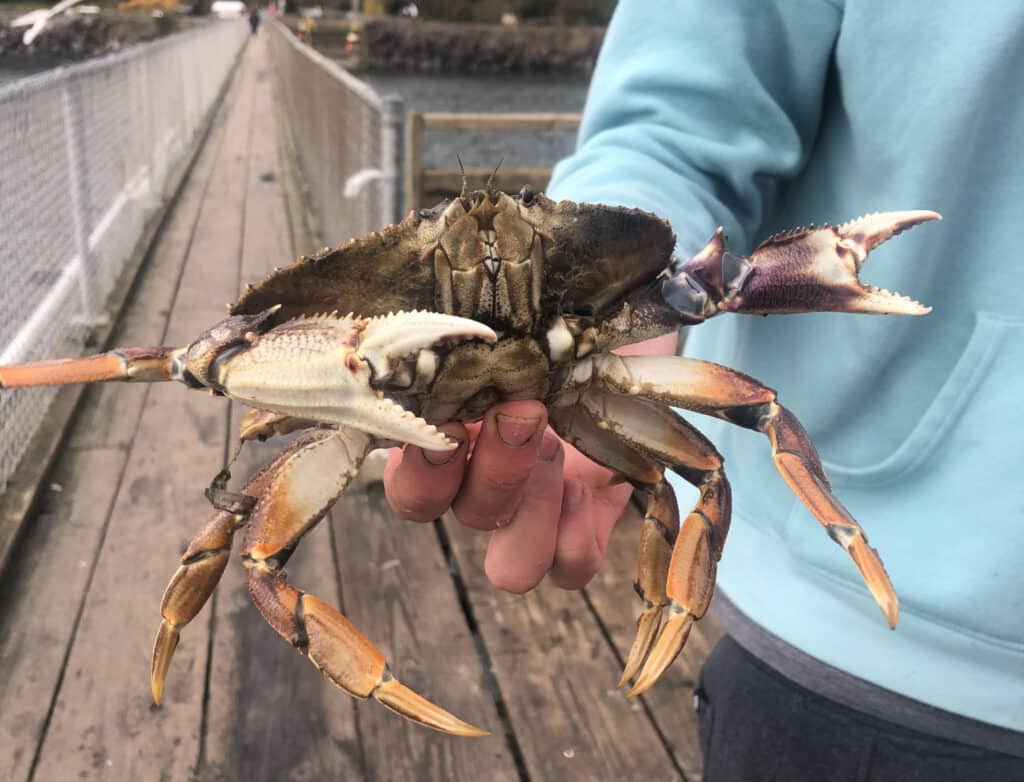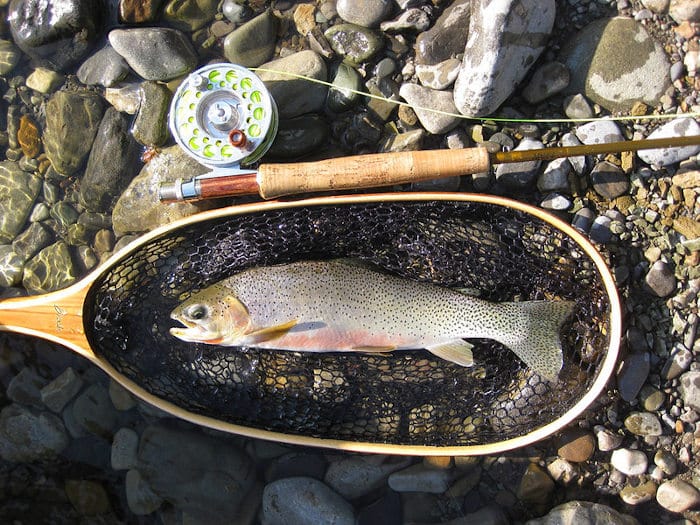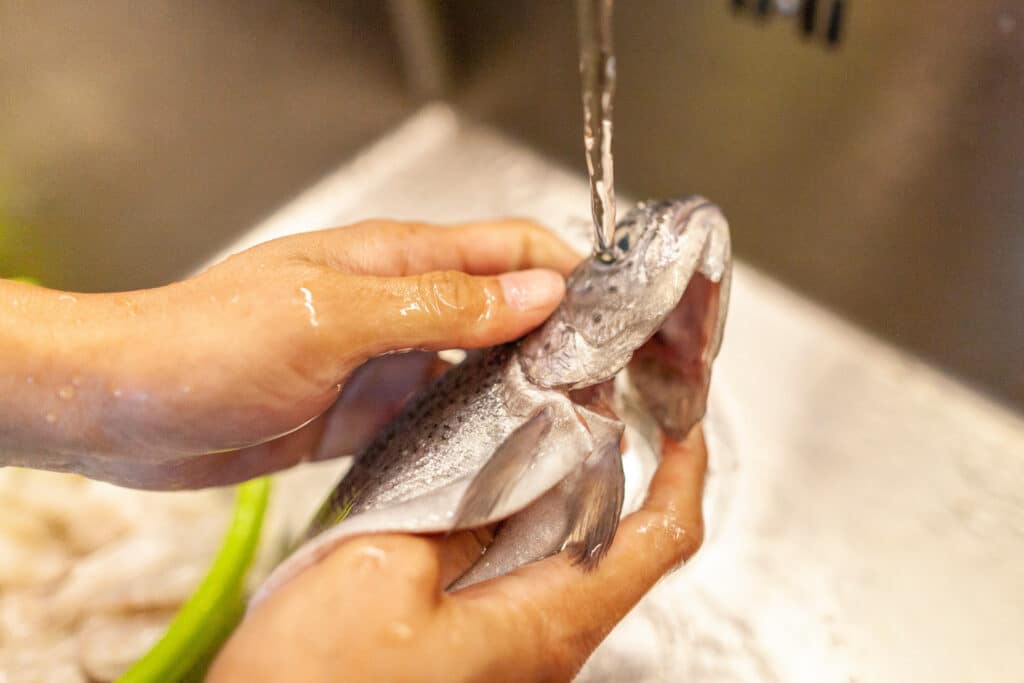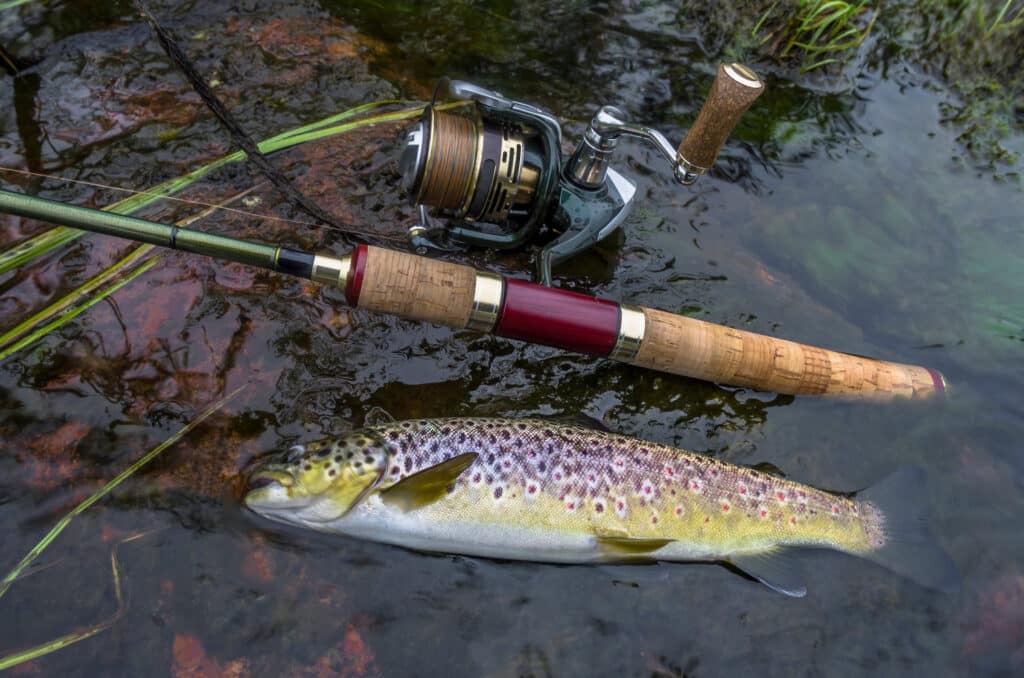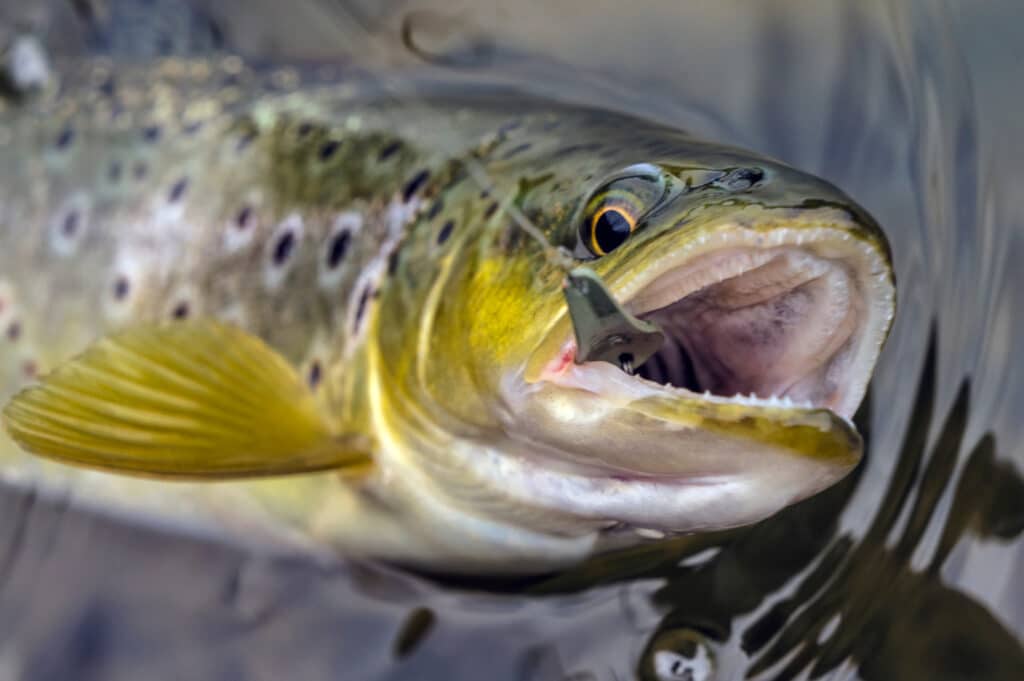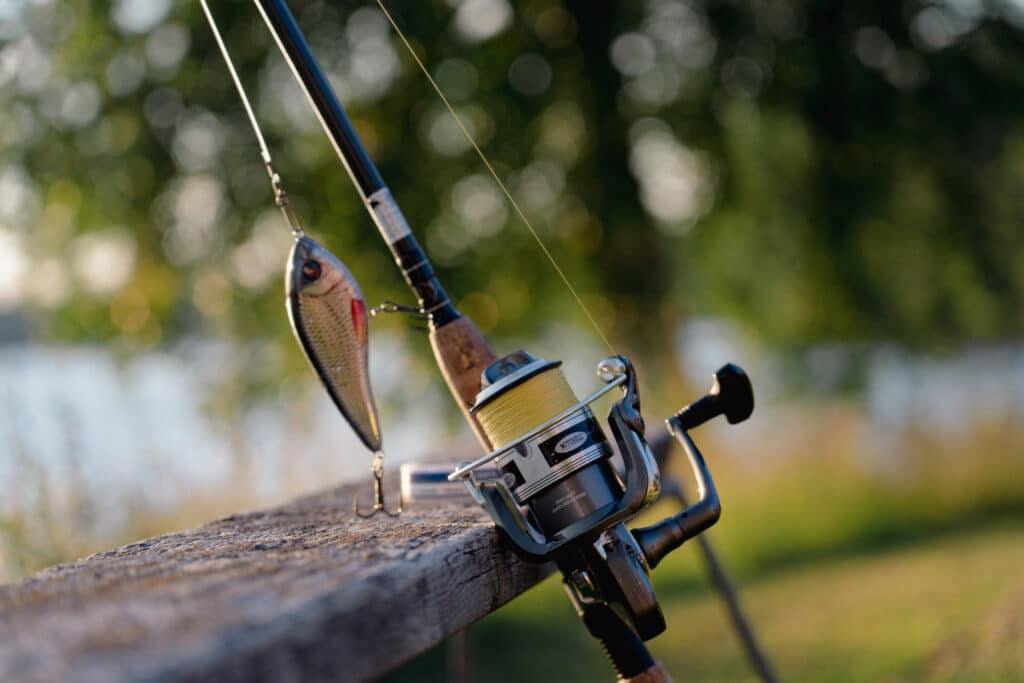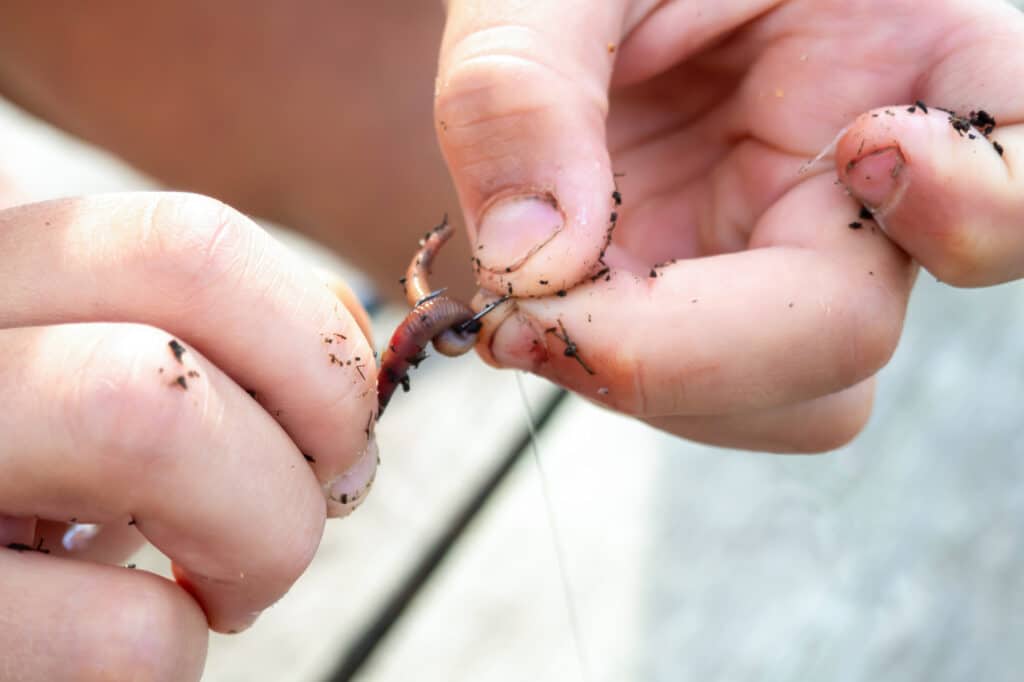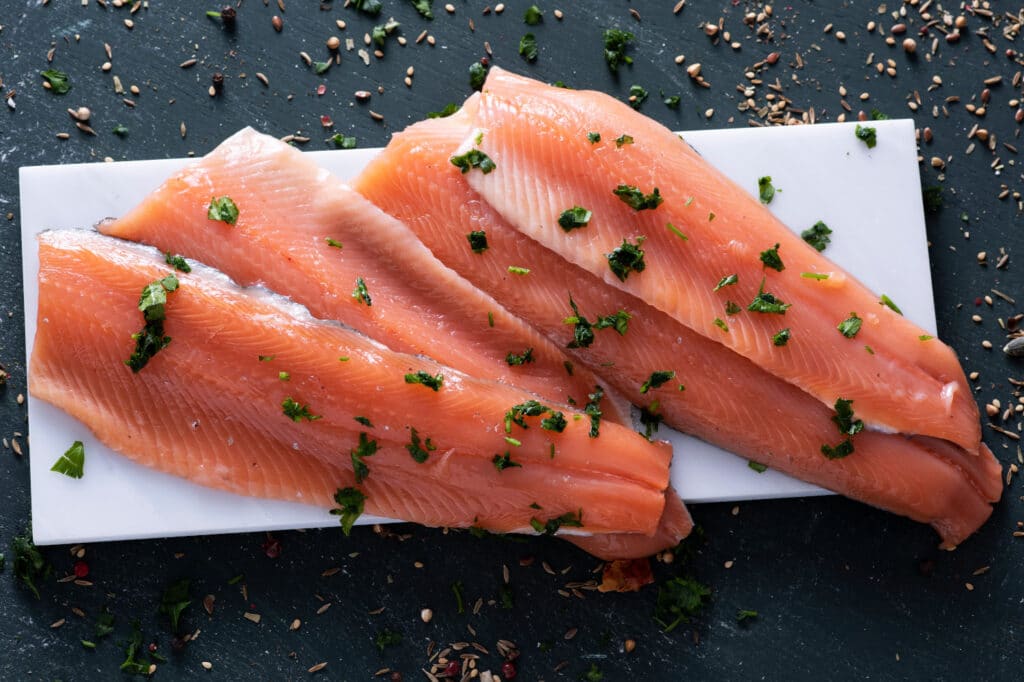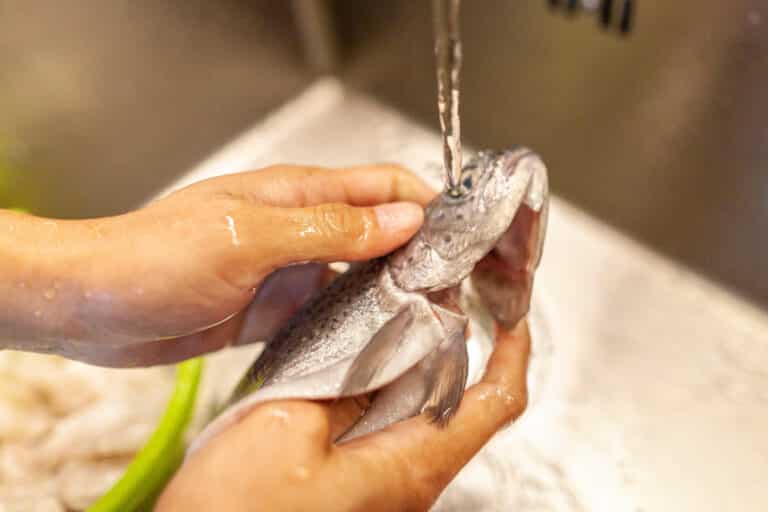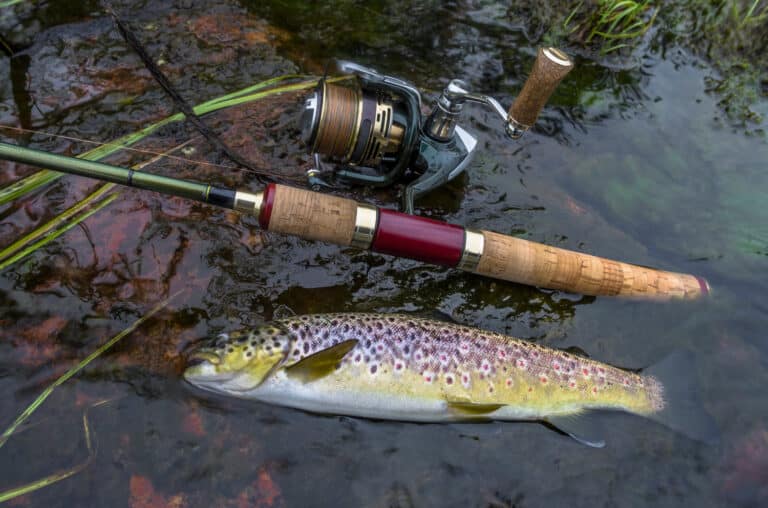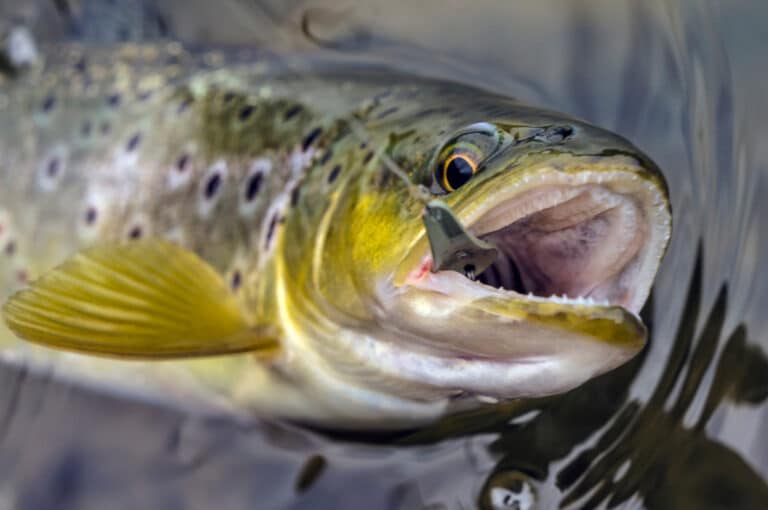Out of all the fishing, foraging, and hunting I’ve done, I probably have crabbing to thank for my obsession with wild foods. Some of my earliest memories are of crabbing with my family on the Oregon Coast, throwing pots off a pier, and hoping for a monster Dungeness Crab. I didn’t know it then, but Dungeness Crab are some of the tastiest food on earth, and catching these expensive morsels yourself makes them taste all that much better.
For anyone within a day’s drive of the west coast, a crabbing trip should be at the top of your to-do list. It’s one of the simplest ways to get a delicious (and otherwise expensive) meal from nature, and it’s a ton of fun, too.
In this guide, I’ll go over everything you need to know to successfully go crabbing on the Oregon coast. I’ll cover the best places to crab, the gear you need, and tips and tactics to give you the best shot at catching dinner.
The Wild Provides is a participant in the Amazon Affiliate program. If you click through one of the links on this site and make a purchase, we may receive a small commission at no extra cost to you. It helps to keep us up and running, but all recommendations are my own honest opinions.
Oregon Crabbing Overview
Crabbing is a pretty simple pursuit. It involves throwing baited traps (called pots or rings) off a boat or pier, waiting a while, and pulling them back up to see what you caught. There are plenty of public-access crabbing piers in Oregon, making crabbing an easy and relatively inexpensive activity.
The real prize in Oregon is the Dungeness Crab, considered by west-coast natives to be the best-tasting crab of all. But Oregon also has solid populations of red rock crabs, a small native crab with sweet, tasty meat. The problem with red rock is that per pound, they don’t have near as much meat as Dungeness crabs, and really only the claws are worth the effort. Dungeness crab is always the goal, but if you happen to catch a few red rock with big claws, it wouldn’t hurt to throw them in the cooler, too.
Once you get a look at these two species, it’s easy to tell the difference. But here are a couple of photos for reference.
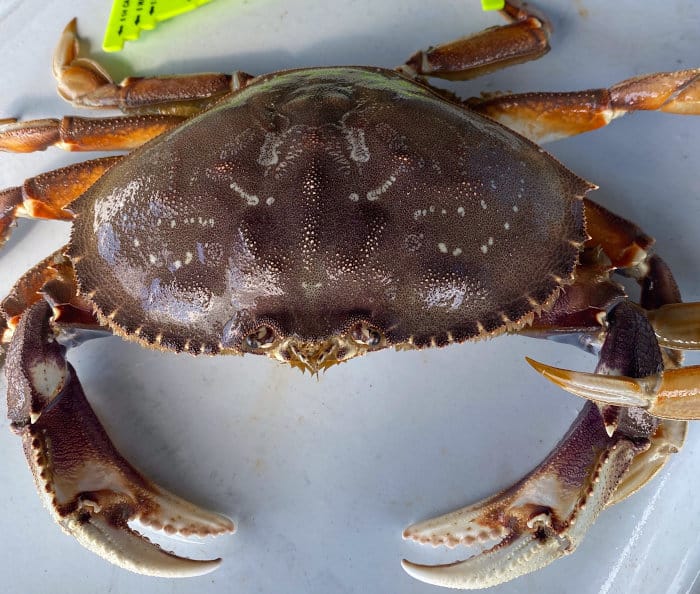
Dungeness: Often purple to brown in color, white claw tips
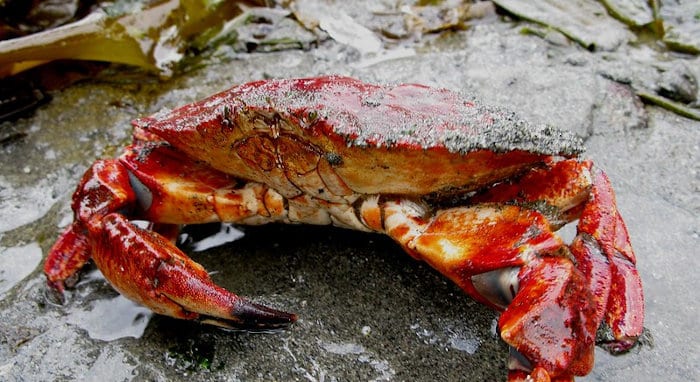
Red Rock: Longer body, knobbier shell, red color, large claws, black tips on the claw
When To Go Crabbing In Oregon
If you’re planning a trip, you want to make sure you’re there at the right time to have the best chance of success. Crabbing is open and legal year-round on Oregon’s beaches and bays, but traditional wisdom says the best time of year to go crabbing is in “months that end in R.” Adult crabs molt once a year in early summer, so crabbing in the summer means mushy crabs with little meat. And commercial crabbing starts in early winter, so crab numbers can drop significantly starting in January or so.
We’ve had success at all times of the year, but September through November (and into December, depending on when the commercial crabbing season opens) are typically the best months to go.
As far as the best time of day to go crabbing, everything is dictated by the tides. Crabs aren’t especially strong swimmers, so they’ll dig themselves into the sand when the water is moving fastest. But right at high or low tide, the water stops moving and the crabs come out to feed. These peaks are called “slack tides,” with 30 minutes on each side of high or low being the best time.
Though this only gives you an hour of peak crab activity, the truth is that as the water movement starts to slow down, crabs will start moving around. We’ve been successful crabbing for up to two hours before and after high tide, so go early and get started before the crowds move in for slack water.
If you’re crabbing from a boat, you can take advantage of low-tide slack water, too. But when pier or dock crabbing, usually only high tides will have deep enough water to have success.
Where To Go Crabbing On The Oregon Coast
The Oregon coast is great in that just about every bay has healthy populations of crabs. That said, there are some that produce better than others. If you’re planning a crabbing trip, it would a good idea to go to one of these top crabbing bays.
Tillamook Bay
I’ve spent more time crabbing on Tillamook Bay than any other bay in Oregon. I have reasons other than just crabbing (with nearby razor clamming and salmon fishing being the main ones), but Tillamook is also widely considered the best crabbing bay in Oregon. In the port town of Garibaldi, there are three public-access piers, as well as a boat launch and marina where you can rent gear or boats and buy bait and licenses. The piers are big and easily accessible, and if you have a boat, the second-largest bay in Oregon offers plenty of room to spread out your pots.
Dungeness crabs dominate Tillamook Bay, but there are a few red rock crab around, too.
Yaquina Bay
Yaquina bay is the bay that the city of Newport is based around. There is a huge public crabbing pier on the south side of the bay and two public docks on the north side, right in the historic bayfront area. Yaquina doesn’t offer as much room for boaters as Tillamook bay, but crabbing from a boat can be great here as well.
Yaquina bay is home to both Dungeness and red rock crabs. Red rocks are abundant here, and since there are no size or sex restrictions on red rocks, you can just about guarantee you’ll go home with some crabs.
Coos Bay
It stands to reason that Oregon’s largest bay is also one of its best bays for crabbing. There are several public crabbing docks, including Charleston Marina, and Coos bay has some great beach crabbing access as well. If you have a boat, this bay is plenty big enough to spread out.
Dungeness and red rock are available here, and if you’re looking for a 2-for-1 Coos bay also offers some of the best clam digging in the state.
Netarts Bay
Only 20 minutes south of Tillamook, Netarts bay is unique in that it isn’t created by a major river. The entire bay is salty enough for crabs to live in, so they’re found in good numbers across the whole bay. There aren’t any public docks, but there are several great beach crabbing spots on the north side of the bay, from the mouth all the way to the interior. Throwable traps work best from the beach, but you can also rent a crab boat (or bring your own) to access more of the bay.
Dungeness crab is the main species in Netarts Bay, but you’ll find a few red rock here, too.
Other Bays
There are over 100 bays in Oregon, and every single one is home to Dungeness Crab. If you want to visit a bay other than my favorites, keep a couple of things in mind; water quality and access. Some bays, like the Nestucca, are small and fed by large rivers that keep most of the water in the bay too fresh for crabs. There are also bays in Oregon that just don’t have much public access for crabbing, which makes it much harder to actually get to where the crabs are. With those things in mind, here are a few more great Oregon crabbing bays:
- Nehalem Bay: Dock access for a fee and boat rental, Dungeness and red rock
- Alsea Bay: Beach crabbing and boat rentals, Dungeness
- Siletz Bay: Beach crabbing and boat rentals, Dungeness
- Siuslaw River: Public docks and beach access, Dungeness
Crabbing Rules and Regulations
Crabs are an important natural resource in Oregon, and they’re managed to protect the population. This means there are strict rules on size, sex, and number for Dungeness crab, and a catch limit for Red Rock. Regulations can change, so always check with the Oregon Department of Fish and Wildlife before crabbing. But for as long as I’ve been crabbing there, these are the rules for Dungeness crabs:
- Size: Must be 5 3/4″ or greater, measured across the widest part of the shell (not including the points)
- Sex: Must be male
- Daily limit per person: 12 crabs
- No more than three traps per person
- Season: year-round on beaches and bays, ocean waters are typically closed in the fall
And for Red Rock:
- Size: no size limit
- Sex: either male or female
- Daily limit per person: 24 crabs
- No more than three traps per person
- Season: year-round on beaches and bays, ocean waters are typically closed in the fall
You are also required to buy an Oregon shellfish license, which at the time of writing is $10 for an annual resident license or $28 for an annual nonresident license. Nonresidents can also buy a $19 three-day license, which works well for most out-of-state visitors. A shellfish license also lets you dig for clams or pick mussels, so jump on that opportunity if you can!
You can buy Oregon licenses online here, or at almost any sporting goods store or Bi-Mart.
If this seems like too much to remember, it really isn’t too difficult once you get out there. First, you can pick up a crab measuring gauge at any sporting goods store along the coast (or get this one from Amazon), and most measuring gauges even have a diagram to help you tell the males and females apart. Once you know what you’re looking at, it’s easy.
The “apron” on the underside of a male crab appears long and pointy. A female apron is much wider and shorter.
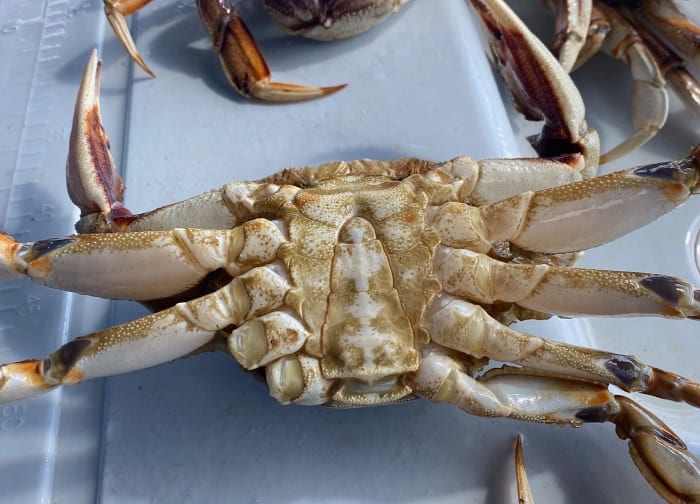
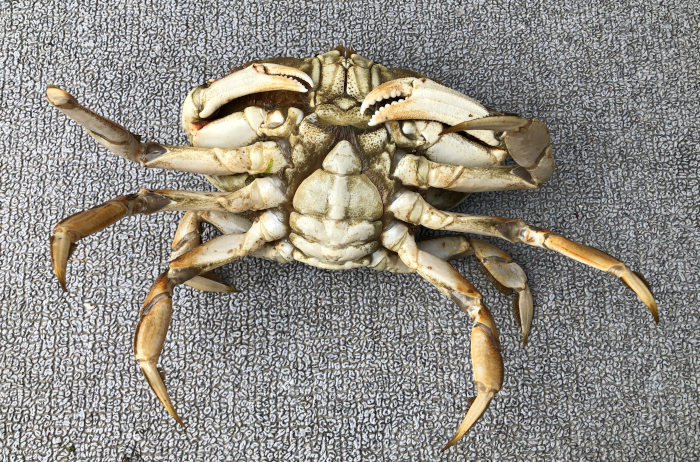
The only thing to remember when measuring crabs is that you have to place the gauge just inside of the points on the shell. If you can fit the gauge over the crab, it’s too small.
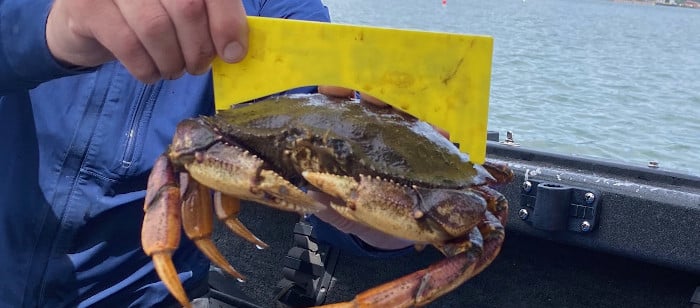
Required Crabbing Gear
You don’t need a lot of gear to go crabbing. You just need some kind of trap (usually a pot or ring), rope (and buoy if you have a boat), and bait. Most Oregon bays will have somewhere to rent all of this stuff, often for around $20 or $30 a day. If you want to buy, though, you can get a couple of pots and everything else you need for less than 100 bucks.
Crab Rings
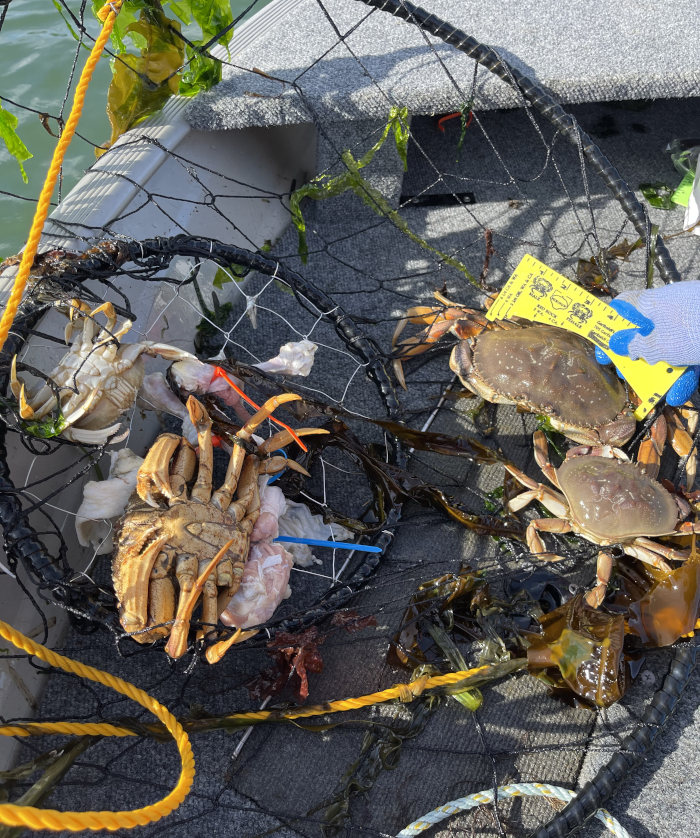
The cheapest and most popular type of trap for dock and pier crabbing is called a crab ring.
Crab rings are just two metal hoops, one smaller than the other, connected by netting. When laid on the ocean floor, it’s completely flat. But when you pick it up becomes a bucket, trapping the crabs inside as you pull it up.
Rings can be purchased at a lot of sporting goods stores for $30-$40 a piece, and they pack flat for easy transport. You can also get high-quality Protoco rings on Amazon.
The important thing to remember with rings is to pull quickly because crabs can climb out of the top of the ring if you pull too slowly. They can be pulled as often as every 5 minutes if the crabbing is hot, but a good starting point is 10-15 minutes between pulls.
Crab Pots
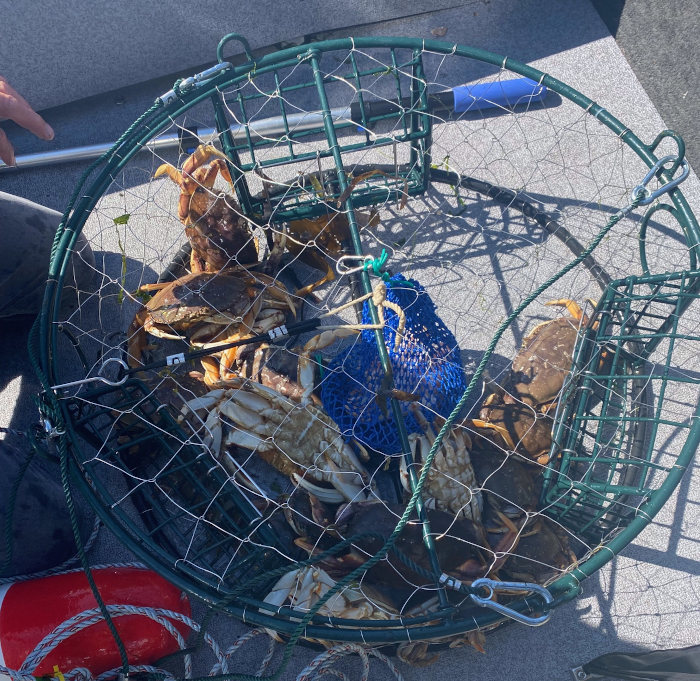
Pots are what commercial fisherman use. These are essentially cages with one-way doors that let the crabs go in, but not out. Crab pots are a more surefire way of catching Dungeness, but they require a longer soak of 20 minutes or more. They aren’t as active or fun as rings, but they’re just as effective.
Pots are typically more expensive than rings, but Danielson makes a collapsible square pot that runs about 35 bucks on Amazon. I have several, and they’re perfect for weekend warriors because they store flat, are cheap, and work great (rope is sold separately).
Other Crab Traps
The majority of Oregon coast crabbers use rings or pots, but there are other traps you might want to consider, especially if you only have beach access.
The first is called the Crab Hawk (a brand name; Promar and others make similar traps). It’s a castable or throwable trap that lays flat on the ocean floor, but snaps shut when you pull it up. Crab hawks work great in places like Netarts Bay, where the crabs are close but beach access is the only option.
Crab snares are the second castable option, which are just small bait cages surrounded by 6-10 sliding wire loops. The idea is that as a crab tries to get the bait, its legs will go through at least one of these loops. Then when you reel in, the loop cinches and the crab comes up with it. You can find these in most coastal sporting goods stores, as well as Amazon.
Crab snares work surprisingly well, and if you have a strong surf fishing rod you can even use snares to cast from the beach straight into the ocean. I’ve often casted a crab snare while jetty fishing just to up the odds of coming home with dinner.
Rope/Buoy
Some pots come with rope included, but if yours doesn’t then you’ll want at least 50 feet of rope.
If you’re boat crabbing, you’ll want to buy sinking line so the rope doesn’t get tangled in your boat propeller. You’ll also need a buoy, and in Oregon, you have to mark the buoy with your name and your phone number or ODFW ID number.
Even when pier crabbing, I like to have a buoy at the end of each line to know for sure which lines are mine. It’s not necessary, but it can be helpful.
Bait
Without something to draw the crabs in, you’re never going to catch any. I wrote a whole post on the best crab baits, but I’ll give you the quick lowdown here, too.
Luckily you can use just about anything as bait. Local sporting goods stores and marinas often sell fish carcasses and mink carcasses, but you can use chicken legs, broken-up clams, or even roadkill (of a nongame species). The most important thing is that it’s some kind of meat because crabs are carnivores. There are, however, some baits that work better than others.
When I go crabbing, I skip the fish and mink. Fish attracts seals and sea lions, which will try to steal your bait and tear up your pots in the process. Mink just doesn’t work all that well, probably because mink is a lean animal and crabs can more easily smell fats in the water from long distances.
The go-to bait for just about everyone I know is raw chicken, either drumsticks or thighs. It’s irresistible to crabs, and you only need a piece or two per pot to draw in hordes of them.
Another bait that works great is broken-up clams. Clams are a crabs’ natural food source, and though chicken works great, clams seem to work slightly better. I would never buy clams to use as bait, but if you’re going to go clam digging anyway (and you should; read more on Oregon razor clamming here), then you can save a few to throw in your crab pots later. If you’re anywhere south of Pacific City or so, digging for invasive purple varnish clams is a perfect opportunity to get a meal and a ton of crab bait, too.
Other Gear
The gear above is all you need to catch crabs, but there are a few other things that you need to bring along.
- Crab Gauge: essential for measuring legal keeper size
- Oregon shellfish license: required to be on your person whenever you’re crabbing
- Gloves: The best time to crab is in the colder fall and winter months, and gloves also protect your hands from rope burn
- 5-gallon bucket: To carry bait; get one with a lid if possible, because seagulls love to steal unattended bait
- Cooler: For keeping your catch cold
- Tide table book: You can easily check the tide times online now, but you can also grab a tide table book for free or purchase from lots of local businesses. I use tide-forecast.com because it has helpful hour-by-hour charts.
How To Go Crabbing In Oregon
Now that you have all the background information you need, here’s how to go crabbing. The video below is a great intro to all things crabbing, and even includes some underwater footage of a crab feeding frenzy. Read on below for the step-by-step breakdown.
Step 1: Assemble Gear and Bait traps
Double-check to make sure you have everything, then head out to the pier, boat launch, or beach. Baiting traps can be done in a variety of ways, depending on what you have. If you’re using chicken drumsticks, you can simply zip-tie them to the center of your pot or ring. If using clams or fish, you’ll want a bait bag (like these) or bait box (like these) to hold everything together.
Step 2: Drop Your traps
If you have the luxury of space, spread out your traps as much as possible. Then drop them off the pier slowly to make sure they are positioned correctly on the bottom. If you’re renting or using a boat, pay attention to where the other crabbers are. Don’t encroach too much, but dropping relatively close to where other crabbers are having success gives you a good head start.
Step 3: Pull your traps
For rings, you should allow at least 10 minutes between pulls, and for pots, you should allow 20. To keep the action up, I like to pull my pots on a cycle, leaving 5-10 minutes between each pull and soaking each pot for anywhere from 15-30 minutes.
There are days when crabbing is slow, and there are days when it’s red hot. On slow days I’ll soak longer, and on hot days I’ll be pulling traps nearly constantly. Once you get a few pulls in and see what you’re getting, you can adjust the soaking time accordingly.
Step 4: Sort and Size your crabs
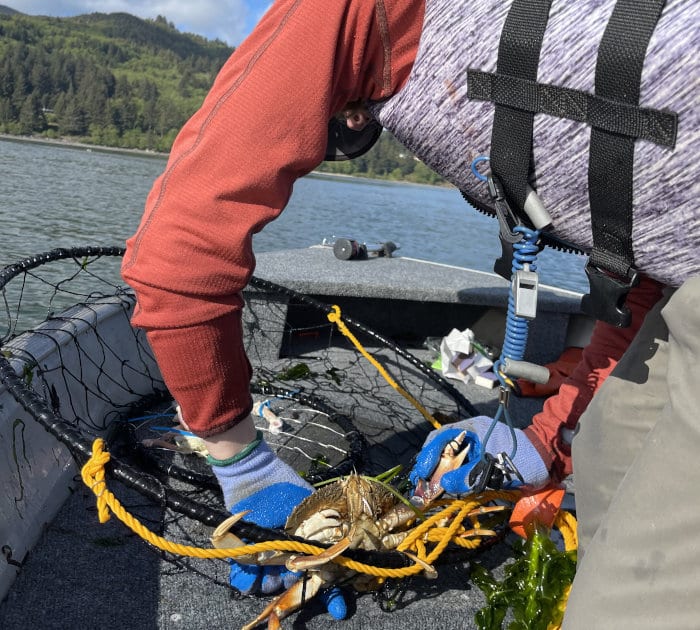
If all has gone well up to this point, you should have some crabs on deck! All that’s left is to sort and size them.
Grabbing each crab from near the back legs and pinching the shell so its front claws can’t reach your fingers, flip the crabs over and check for sex first. Toss any females back into the water, but save the male dungeness for measuring.
When all that’s left are males, check each with your measuring gauge to see if they’re big enough. If they measure 5 3/4 inches across, congrats! You have a keeper crab to throw in the cooler.
Note about coolers/buckets: Crabs can survive for a long time in the fresh air, but they’ll quickly use up all the oxygen in a bucket of water. It’s important that they stay cool, though, so either keep them in a bucket of seawater and change the water every 15-20 minutes, or put them in a cooler on ice. Take care to drain off any water from the melting ice, as fresh water will kill crabs quicker than anything else.
Step 5: Cook ’em and eat ’em
I’m not going to go into crab cooking and cleaning here, because there are a few different techniques and it’s enough for a whole other post. Check out this great article from Sunset for tips on how to cook your catch.
All you need to know is that the best way to eat Dungeness crabs is simple: just crack them in dip them in butter. If you have the luxury of catching more crab than you know what to do with, crab is also great in pasta dishes, cheese melts, and seafood soups.
FAQ
Can You crab at night in oregon?
Yes! Crabs find their food almost entirely by smell, so you can catch them at any time of day. Not all public access locations allow night crabbing, though, so check with your local spot before you head out.
how long should you leave crab traps in the water?
A good rule of thumb is 10-15 minutes for rings, or 20-25 minutes for pots. But once you get a few pulls in, you should adjust your soak time based on how many crabs you pull up. I’ve had days where my bait was picked clean in less than 10 minutes, and others where I had to leave my traps for more than 30 minutes to get a few crabs. Being adaptable is the name of the game.
What is the best bait for crabbing?
I’m going to let you in on a secret; commercial crabbers almost exclusively use clams. Buying clams to use as bait is ridiculously expensive, and you don’t want to hurt clam populations by digging them all up for bait (most clams are very slow to grow). But if you’re in an area with invasive purple varnish clams, you can do the ecosystem a favor and keep up to 72 per person, and get some free crab bait in the process.
Final Thoughts
Crabbing is a fun, easy way to get engaged with nature and source some delicious wild food yourself. It’s really pretty easy, and it’s a rewarding activity that’s great for kids and adults alike. Next time you head to the coast, make sure to put crabbing on your must-do list.

